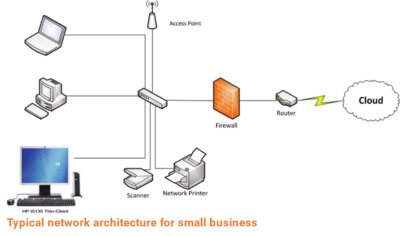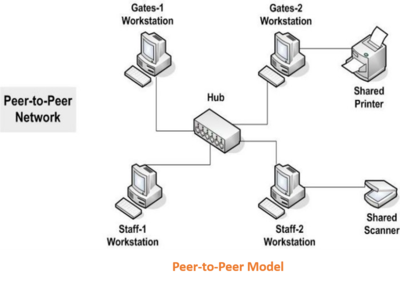Difference between revisions of "Network Architecture"
| Line 5: | Line 5: | ||
[[File:Network Architecture.png|400px|Network Architecture]]<br /> | [[File:Network Architecture.png|400px|Network Architecture]]<br /> | ||
source: [https://www.researchgate.net/profile/Shadi_Aljawarneh/publication/220195540_Cloud_Security_Engineering_Avoiding_Security_Threats_the_Right_Way/links/53d128a70cf2a7fbb2e62850/Cloud-Security-Engineering-Avoiding-Security-Threats-the-Right-Way.pdf Shadi Aljawarneh] | source: [https://www.researchgate.net/profile/Shadi_Aljawarneh/publication/220195540_Cloud_Security_Engineering_Avoiding_Security_Threats_the_Right_Way/links/53d128a70cf2a7fbb2e62850/Cloud-Security-Engineering-Avoiding-Security-Threats-the-Right-Way.pdf Shadi Aljawarneh] | ||
| + | |||
| + | |||
| + | __TOC__ | ||
| Line 21: | Line 24: | ||
| − | == Network Architecture and OSI Model == | + | == Network Architecture and OSI Model<ref>Network Architecture and OSI Model [https://en.wikipedia.org/wiki/Network_architecture Wikipedia]</ref> == |
The Open Systems Interconnection model (OSI model) defines and codifies the concept of layered network architecture. Abstraction layers are used to subdivide a communications system further into smaller manageable parts. A layer is a collection of similar functions that provide services to the layer above it and receives services from the layer below it. On each layer, an instance provides services to the instances at the layer above and requests service from the layer below. | The Open Systems Interconnection model (OSI model) defines and codifies the concept of layered network architecture. Abstraction layers are used to subdivide a communications system further into smaller manageable parts. A layer is a collection of similar functions that provide services to the layer above it and receives services from the layer below it. On each layer, an instance provides services to the instances at the layer above and requests service from the layer below. | ||
| + | |||
| + | |||
| + | == Network Architecture Distributed Computing<ref>Network Architecture Distributed Computing [https://en.wikipedia.org/wiki/Network_architecture Wikipedia]</ref> == | ||
| + | In distinct usage in distributed computing, the network architecture often describes the structure and classification of a distributed application architecture, as the participating nodes in a distributed application are often referred to as a network.[2] For example, the applications architecture of the public switched telephone network (PSTN) has been termed the Intelligent Network. There are a number of specific classifications but all lie on a continuum between the dumb network (e.g. the Internet) and the intelligent network (e.g. the PSTN). | ||
| + | |||
| + | A popular example of such usage of the term in distributed applications, as well as permanent virtual circuits, is the organization of nodes in peer-to-peer (P2P) services and networks. P2P networks usually implement overlay networks running over an underlying physical or logical network. These overlay networks may implement certain organizational structures of the nodes according to several distinct models, the network architecture of the system. | ||
| + | |||
| + | |||
| + | == Types of Network Architecture<ref>Types of Network Architecture [https://medium.com/@blazebnayak/types-of-network-architecture-393e4ef5530e Binayak Adhikari]</ref> == | ||
| + | The two types of widely used network architectures are peer-to-peer aka P2P and client/server aka tiered. | ||
| + | *Peer-to-Peer Architecture: In a peer-to-peer network, tasks are allocated to every device on the network. Furthermore, there is no real hierarchy in this network, all computers are considered equal and all have the same abilities to use the resources available on this network. Instead of having a central server which would act as the shared drive, each computer that's connected to this network would act as the server for the files stored on it. | ||
| + | |||
| + | |||
| + | [[File:Peer-to-Peer Model.png|400px|Peer-to-Peer Model]]<br /> | ||
| + | source: Binayak Adhikari | ||
| + | |||
| + | |||
| + | *Advantages of a peer-to-peer network | ||
| + | **Does not require a dedicated server which means its less costly. | ||
| + | **If one computer stops working, the other computers connected to the network will continue working. | ||
| + | **Installation and setup is quite painless because of the built-in support in modern operating systems. | ||
| + | *Disadvantages of a peer-to-peer network | ||
| + | **Security and data backups are to be done to each individual computer. | ||
| + | **As the numbers of computers increases on a P2P network… performance, security, and access becomes a major headache. | ||
| + | |||
| + | |||
| + | *Client/Server Architecture: Client-server architecture, architecture of a computer network in which many clients (remote processors) request and receive service from a centralized server (host computer). In a client/server network, a centralized, really powerful computer(server) acts as a hub in which other computers or workstations(clients) can connect to. This server is the heart of the system, which manages and provides resources to any client that requests them. | ||
| + | |||
| + | |||
| + | [[File:Client -Server Model.png|400px|Client/Server Model.png]]<br /> | ||
| + | source: Binayak Adhikari | ||
| + | |||
| + | |||
| + | *Advantages of a client/server network | ||
| + | **Resources and data security are controlled through the server. | ||
| + | **Not restricted to a small number of computers. | ||
| + | **Server can be accessed anywhere and across multiple platforms. | ||
| + | *Disadvantages of a client/server network | ||
| + | **Can become very costly due to the need of a server as well as networking devices such as hubs, routers, and switches. | ||
| + | **If and when the server goes down, the entire network will be affected. | ||
| + | **Technical staff needed to maintain and ensure network functions efficiently. | ||
Revision as of 14:34, 8 July 2021
What is Network Architecture?[1]
Network Architecture is the complete framework of an organization's computer network. The diagram of the network architecture provides a full picture of the established network with detailed view of all the resources accessible. It includes hardware components used for communication, cabling and device types, network layout and topologies, physical and wireless connections, implemented areas and future plans. In addition, the software rules and protocols also constitute to the network architecture. This architecture is always designed by a network manager/administrator with coordination of network engineers and other design engineers.

source: Shadi Aljawarneh
Evolving Network Architecture[2]
Network architecture matters not just for internal operations but also for consumer interaction with companies. Consumerization and increased use of technology have made it crucial that companies provide platforms that are user-friendly and, for the most part, glitch-free. Consumers do not want slow and cumbersome shopping experiences or processes that require many steps. For example, many companies now offer auto fill-in capabilities so repeat customers have less hassle when checking out. Cloud architecture enables better market agility through traffic partitioning.
Cloud Architecture
When constructing a network, ORACLE recommends studying the different traffic patterns over the network. Cloud computing offers many benefits, but if constructed poorly, a cloud infrastructure can be inefficient. For example, a single network interface used with a multi-node configuration will not be able to accommodate high cloud network traffic. Utilizing different networks/subnetworks to isolate traffic maximizes efficiency and improves functionality. Types of traffic may include guests, storage, or management.
Components of Modern Network Architectures[3]
The industry is now using architectures that ease the burden of building and maintaining computer networks for the digital age.
- Intent-based networking (IBN): An intent-based network takes an organization's desired outcomes at a high level as input and sets up the network to achieve these objectives. It does so by automating operations extensively, analyzing network performance, pinpointing problematic areas, providing all-around security, and integrating with business processes.
- Controller-led: Network controllers are foundational to intent-based networking and are essential to scaling and securing networks in the digital era. Controllers dramatically simplify operations and help organizations respond rapidly to changing business requirements. They automate networking functions by translating business intent into device configurations, and they monitor the network devices continuously to help ensure performance and security.
- Multidomain: Multiple networks in an enterprise communicate with one another through their controllers. Such cross-network, or multidomain, integrations generally involve exchanging relevant operating parameters to help ensure that desired business outcomes that span networking domains are achieved.
Network Architecture and OSI Model[4]
The Open Systems Interconnection model (OSI model) defines and codifies the concept of layered network architecture. Abstraction layers are used to subdivide a communications system further into smaller manageable parts. A layer is a collection of similar functions that provide services to the layer above it and receives services from the layer below it. On each layer, an instance provides services to the instances at the layer above and requests service from the layer below.
Network Architecture Distributed Computing[5]
In distinct usage in distributed computing, the network architecture often describes the structure and classification of a distributed application architecture, as the participating nodes in a distributed application are often referred to as a network.[2] For example, the applications architecture of the public switched telephone network (PSTN) has been termed the Intelligent Network. There are a number of specific classifications but all lie on a continuum between the dumb network (e.g. the Internet) and the intelligent network (e.g. the PSTN).
A popular example of such usage of the term in distributed applications, as well as permanent virtual circuits, is the organization of nodes in peer-to-peer (P2P) services and networks. P2P networks usually implement overlay networks running over an underlying physical or logical network. These overlay networks may implement certain organizational structures of the nodes according to several distinct models, the network architecture of the system.
Types of Network Architecture[6]
The two types of widely used network architectures are peer-to-peer aka P2P and client/server aka tiered.
- Peer-to-Peer Architecture: In a peer-to-peer network, tasks are allocated to every device on the network. Furthermore, there is no real hierarchy in this network, all computers are considered equal and all have the same abilities to use the resources available on this network. Instead of having a central server which would act as the shared drive, each computer that's connected to this network would act as the server for the files stored on it.
- Advantages of a peer-to-peer network
- Does not require a dedicated server which means its less costly.
- If one computer stops working, the other computers connected to the network will continue working.
- Installation and setup is quite painless because of the built-in support in modern operating systems.
- Disadvantages of a peer-to-peer network
- Security and data backups are to be done to each individual computer.
- As the numbers of computers increases on a P2P network… performance, security, and access becomes a major headache.
- Client/Server Architecture: Client-server architecture, architecture of a computer network in which many clients (remote processors) request and receive service from a centralized server (host computer). In a client/server network, a centralized, really powerful computer(server) acts as a hub in which other computers or workstations(clients) can connect to. This server is the heart of the system, which manages and provides resources to any client that requests them.
- Advantages of a client/server network
- Resources and data security are controlled through the server.
- Not restricted to a small number of computers.
- Server can be accessed anywhere and across multiple platforms.
- Disadvantages of a client/server network
- Can become very costly due to the need of a server as well as networking devices such as hubs, routers, and switches.
- If and when the server goes down, the entire network will be affected.
- Technical staff needed to maintain and ensure network functions efficiently.
- ↑ Definition - What Does Network Architecture Mean? Techopedia
- ↑ Evolving Network Architecture RSI security
- ↑ Components of Modern Network Architectures Cisco
- ↑ Network Architecture and OSI Model Wikipedia
- ↑ Network Architecture Distributed Computing Wikipedia
- ↑ Types of Network Architecture Binayak Adhikari


